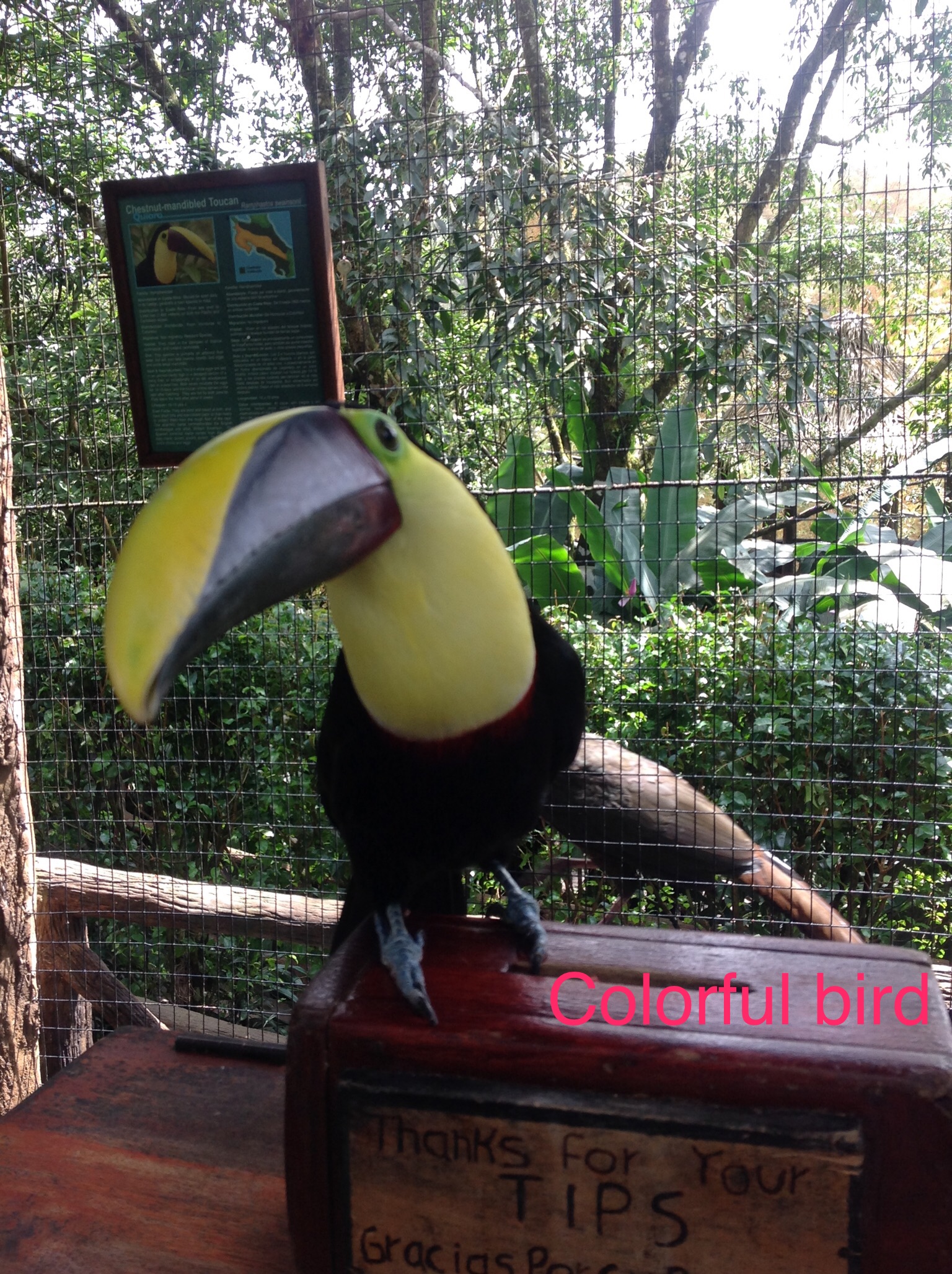
Image: Arenal Volcano via Wikimedia Commons
Costa Rica’s rainforests are some of the most stunning in the world – and full of birds, iguanas, monkeys, sloths and caimans. Students met many species of toucans, parrots, and hummingbirds in Costa Rica (including the following friends). Costa Rica has over 800 species of birds due to the climate and ecosysem(s) there–so bird watching is always a great activity in Costa Rica.

Image: Hummingbird: Creative Commons
Helpful books on bird watching include Birds of Costa Rica by F. Gary Stiles and Alexander Skutch (Cornell University Press) and An Illustrated Field Guide to Birds of Costa Rica, illustrated by Victor Esquivel Soto.

Image: Parrot via Wikimedia Commons
List of Costa Rican Birds:
16 species of parrots including the fabulous scarlet macaw.
50 species of hummingbirds.
10 species of trogons with the resplendent quetzal as the jewel.
6 species of toucans, including the keel-billed and chestnut-mandibled.
Half the bird species in Costa Rica are passerines including warblers, sparrows and finches.
16 species of ducks, including the fulvous whistling, white-faced ruddy and American wigeon.
13 species of falcons, including the peregrine falcon, merlin and American kestrel.
36 species of prey, including the gray hawk, swallow-tailed kite, solitary eagle and northern harrier.
6 species of cracidae which look like turkeys.
8 species of new world quails.
15 species of rallideas including the rufous-necked wood-rail, American coot and ruddy crake.
19 species of owls including the black-and-white, Costa Rican pygmy, central American pygmy and striped.
3 species of potoos including the great, northern and common.
16 species of woodpeckers, including cinnamon, chestnut-colored and pale-billed.
The coastal list of birds includes:
19 species of herons & wading birds such as the great blue heron, great egret, boat-billed heron, reddish egret and yellow-crowned night-heron.
2 species of recurvirostridae which are waders and include the black-necked stilt and American avocet.
2 species of jacanas including the northern and wattled.
34 species of scolopacidae including the short-billed dowitcher, spotted sandpiper, wandering tattler, surfbird, and red phalarope.
9 species of gulls including the gray, Heermann’s and ring-billed.
14 species of sternidae (terns) including the gull-billed tern, Forster’s tern, least tern and white tern.
4 species of vultures including the king vulture.
24 species of doves and pigeons.
11 species of swifts including the black, spot-fronted and Costa Rican.
6 species of kingfishers including the green, Amazon and American pygmy.
5 species of threskiornithidaes including the roseate spoonbill and white-faced ibis.
2 species of ciconiidae including the wood stork and jabiru.
Good Bird watching spots include:
Monteverde Cloud Forest has more than 400 species of birds, including resplendent quetzals.
Tortuguero National Park has 300 species of birds.
Santa Rosa National Park has more than 250 species of birds.
Cahuita National Park has toucans, parrots, rufous kingfishers; the park is on the beach.
La Selva Biological Station in the northern lowlands has 420 species of birds.
Helconia Island has 228 species of birds.
Corcovado National Park has 400 species of birds and 1,200 scarlet macaws.
Huedal Nacional Terraba-Sierpe has a myriad of birds along the coast and swamps.
Carara National Park has 400 species of birds.
Tárcoles has 400 species of birds and great river tours highlighting crocodiles.
Whale Marine National Park has frigate birds, boobies, ibises and pelicans.
La Amistad National Park has 500 species of birds including resplendent quetzals.
Manuel Antonio National Park has 350 species of birds and three lovely beaches (Wikipedia).
Works Cited
“Birdlist.org: Birds of Costa Rica,” World Institute for Conservation and Environment, 2018, http://www.birdlist.org/costa_rica.htm
Editors of US News and World Report. “Costa Rica Travel Guide,” US News and World Report, 2018, https://travel.usnews.com/Costa_Rica/
“List of Birds of Costa Rica,” Wikipedia, 2018, https://en.wikipedia.org/wiki/List_of_birds_of_Costa_Rica
Soto, Victor Esquivel. An Illustrated Field Guide to Birds of Costa Rica, Incafo Costa Rica, 2003.
Stiles, Gary F. and Alexander Skutch. Birds of Costa Rica. Cornell University Press, 1989.
Cover Image Courtesy of Paul Grizzelle-Reid

